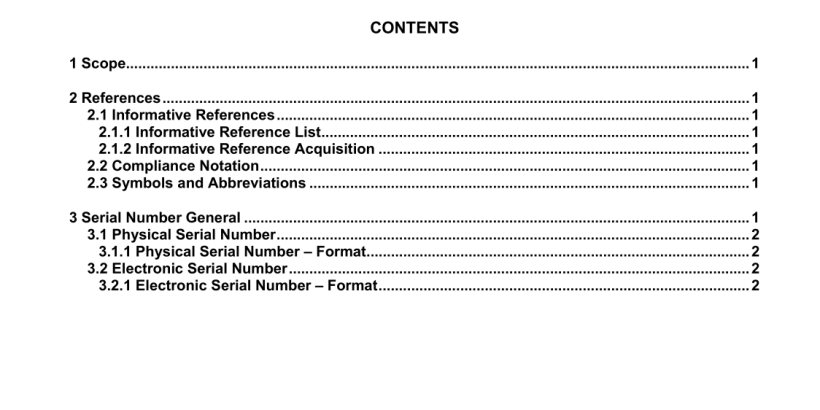ANSI CTA-2063-2017 pdf download.Small Unmanned Aerial Systems Serial Numbers
1 Scope
This standard outlines the elements and characteristics of a serial number to be used by small unmanned aerial systems.
2 References
2.1 Informative References
The following references contain provisions that, through reference in this text, constitute informative provisions of this standard. At the time of publication, the edition indicated was valid. All standards are subject to revision, and parties to agreements based on this standard are encouraged to investigate the possibility of applying the most recent edition of the standard indicated below.
2.1.1 Informative Reference List
1. 3GPP TS 23.003, Numbering, addressing and identification
2.1.2 Informative Reference Acquisition
1. 3GPP, 650, route des Lucioles, 06921 Sophia Antipolis Cedex, France, www.3GPP.org
2.2 Compliance Notation
As used in this document “shall” and “must” denote mandatory provisions of the standard. “Should” denotes a provision that is recommended but not mandatory. “May” denotes a feature whose presence does not preclude compliance, and implementation of which is optional. “Optional” denotes items that may or may not be present in a compliant device.
CTA, in collaboration with all stakeholders, is responsible for developing and maintaining procedures that specify the procedure to be followed pertaining to the acquisition and regulation of the PSN Manufacturer’s Codes. As Manufacturer Code Administrator, CTA manages the PSN Manufacturer’s Code component. The remaining segment of the PSN, the Serial Number, will be directly administered by the manufacturer to which the PSN Manufacturer Code is assigned.
The Manufacturer (MFR) Code is a 4 character alphanumeric code (Note: MFR Codes shall include any combination of digits and uppercase letters, except the letters O and I, but may include all digits.) The Length Code is a single alpha character that corresponds to the number of characters in the serial number that is included in the PSN. The alpha characters range from A to T signifying the range of 1 to 20 characters in the serial number (e.g., A = 1, B=2, H=8, T=20). The Length Code will not be included in the ESN. The Serial Number, which is generated by the manufacturer, is an alphanumeric code with a maximum of 20 characters (Note: Serial Number shall include any combination of digits and uppercase letters, except the letters O and I, but may include all digits.) The actual number of characters used by the manufacturer shall be indicated by the preceding Length Code.
3.2 Electronic Serial Number
Each ESN shall comprise four basic components: the Manufacturer’s Code, the Serial Number, the IMEISV Identifier, and Performative Characteristics.
The Manufacturer (MFR) Code is a 4 character alphanumeric code as defined in Section 3.1.1 Physical Serial Number. The Serial Number, which is generated by the manufacturer, is a 20 character alphanumeric code as defined in Section 3.1.1 Physical Serial Number. This serial number shall be represented electronically using ASCII coding of the serial number characters. The serial number shall be a fixed length of 20 bytes. If the physical serial number is less than 20 characters the manufacturer shall pad the serial number with leading bytes with the value 0x00.
If an IMEISV is not used, the IMEISV field shall be filled with 16 bytes with the value 0x00. Seven characters are reserved for performative characteristics of the UAS where the first character indicates the standards body from which the following 6 performative characteristics are defined. CTA will manage the assignment of the code for the standards body responsible for defining the performative characteristics. If any of the 7 performative characteristics characters are not used they shall be padded with bytes with the value 0x00.ANSI CTA-2063-2017 pdf download
